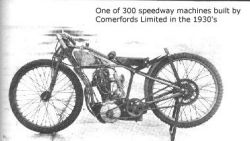

Refurbishing
Apologies for the dropsheets, paint tins and scattered detritus. More information...
The Machine Evolution - 3.
Colin Ford rode a Wallis while Max Grosskreutz had a Harley with an AJS motor; two really hot machines.
With other various models coming into the limelight, the sport was taking on a definite machine interest in
addition to the purely rider side of the question. As the season drew to a close, Frank Arthur was riding a Rudge-engined Wallis; Wal Phillips a Douglas with
Jack Parker also Douglas-mounted. Wal raised the Stamford Bridge flying-mile record to over 45mph, while Syd
Jackson on a Rudge raised the same record at the Leicester Super to just under 50mph! The quantity of dirt track specials exhibited by manufacturers at the 1930 Motorcycle Show at Olympia
was smaller than that of the previous year but the quality distinctively better. Another dirt track machine appeared
for the first time. It was the Sunbeam which had several very good features. The lowest-priced dirt track model
however, was the New Hudson at £59, with an all chromium finish. A bright finish certainly counted on the
tracks, as the speedway public loved colour and noise. The ordinary dirt track Douglas motor developed on an average about 27 brake horse-power (on petrol-
benzole mixture) when it left the works. For an extra £10, any rider could obtain a supertuned engine which
would add at least another 5 bhp. The work was carried out personally by Freddie Dixon and Rex Judd, both of
whom have now sadly passed on. During that 1929 season the Douglas firm had sold about 1,300 dirt track models, which constituted a
remarkable record. Johnie Hoskins asked the company to turn him out machines that made as fiendish a din as
possible and also, if it was possible, a spot of fire-breathing apparatus in the exhaust system would be welcomed! Truly remarkable to an impressive degree was the Company's complete domination of the British, Australian,
European and South American cinder circuits, which varied from around 380 yards per lap to a third of a mile.
The Douglas models used in Britain by the Australian vanguard of powerslide practitioners were built with a frame
made up of a front section of the RA machine and the back section of the OC. As soon as these machines had
demonstrated their superiority over the be-strutted singles that were the contemporary British idea of a dirt track
bike, Douglas Motors Ltd., immediately got to work and put two cinder-trackers into production. These, named
the DT5 and DT6, were identical in every way except their engine capacity, 500 and 600cc respectively. The price,
brand new, as they went on to the market? £85 and £90. Nothing could live with the fabulous dirt Duggies; they were the tracks' ideal machine; they not only out-
accelerated everything else in sight, but they handled on the loose surfaces with inimitable surefootedness and
controllability. So dirt track aspirants to fame and fortune rushed to the Kingswood (Bristol) factory's racing
offices ... with ready cash. Although the Douglas firm spread its wings much further than its rivals, the Company was by no means the
only marque in Britain that carved for itself a permanent niche in the history of speedway racing.Rudge Whitworth, with their 100mph Ulster engine, obtained at least 30bhp and could turn out such motors
in unlimited quantities. Freddie Dixon promised 34bhp with his supertuning on the 1930 special Douglas motor,
and with the Rudge some great dirt track battles were certainly in the offing. The Rudge was almost identical to those that appeared towards the end of the 1928 season, developed from
experiment and experience of Jim Kempster and Arthur Jervis, although its frame was no longer strutted.
Pictured right is Billy Lamont on his 1931 Rudge that were to dominate that season.
However the 1929 season had left no doubt that the Douglas was still by far the most popular and most
successful dirt track machine. Apart from actual race results, the fact that it was possible to attend a meeting and
see nothing but Douglases really proved the point. One thing for 1930 was certain. The battle for supremacy would be a titanic struggle among the various
manufacturers, which could only result in racing of a higher standard than anything yet seen. The real battle would
undoubtedly be between the Douglas and the Rudge, both of which had undisputed sway.
